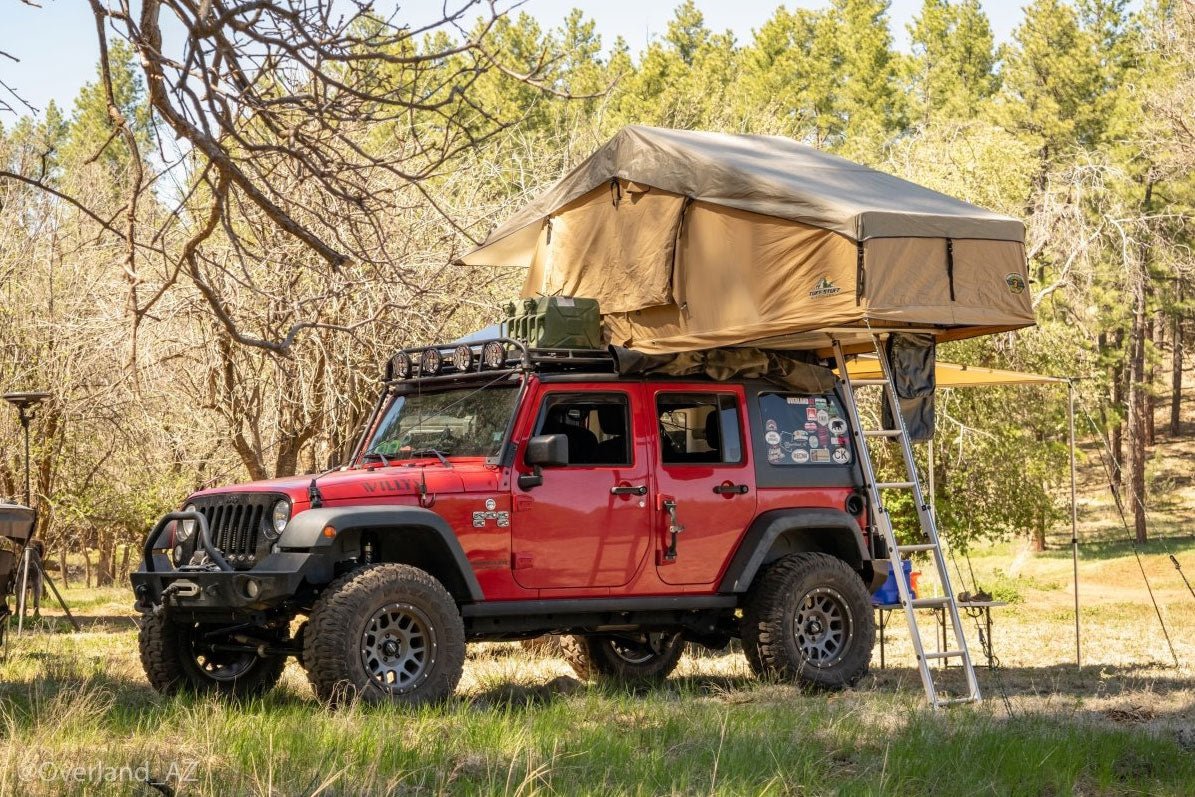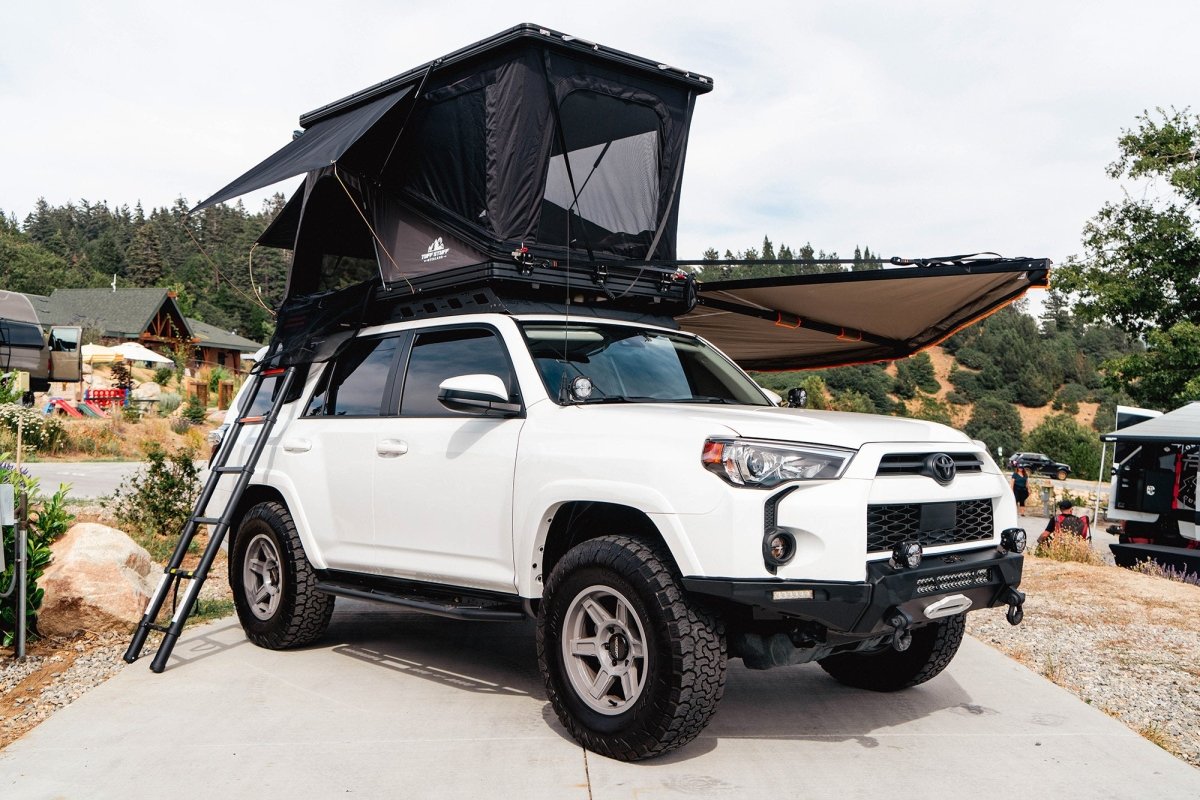Rooftop tents are a perfect fit for campers always on the go. With a tent latched to the roof of your vehicle, you are no longer limited by the constraints of conditions that guide hitching a regular camping tent.
Although this is great news for many campers and overlanders, buying a rooftop tent is only half the battle won as you still have to mount your tent on your vehicle roof properly. Installing your rooftop tent might look like rocket science, but in reality, it is easier than that. Below, we have provided everything you need to know about mounting, installing, and properly securing your rooftop tent on your vehicle.

What’s The Rave About Rooftop Tents?
Are you planning to go camping or on a long overland trip? It is time to invest in a suitable rooftop tent.
Rooftop tents are the ‘in’ thing right now. Campers everywhere are switching from the basic ground tent to this innovative camping gear for great reasons.
Rooftop tents are just what they sound like- tents pitched on the roofs of vehicles. With their ingenious designs, rooftop tents offer campers the luxury of comfort and travel ease they cannot enjoy with regular camping tents.
Rooftop tents are a convenient, handy, easy-to-use alternative to traditional tents. They are designed to be secured to the roof of a camping van, truck, or other camping vehicle. They make it easier for campers to get around and camp in terrains, usually not possible with a ground tent.
One major advantage of rooftop tents is their quick and easy set-up after the initial installation. Once you secure your rooftop tent, you only have to erect and let them down when you find a suitable spot to park and set up camp. This sheltered vantage point off the ground not only makes it easier to set up camp and get in bed but also saves you from the dangers of sleeping on the ground, like experiencing wildlife, bugs, and being stuck in a flood when it rains.
It is also important to add that sleeping in a rooftop tent beats sleeping in your vehicle or on the truck bed. You do not have to spend night after night cramped in an uncomfortable position that will make your body ache when morning comes.
With the luxury, space, convenience, safety, and comfort rooftop tents offer, it is easy to see why anyone will want to own one of these essential camping gear. With no need to spend half an hour knotting ropes to pitch a tent only to tear it down when morning comes or sleeping on hard rocky ground, you can enjoy every minute with nature differently.
In addition, most rooftop tents come fitted with accessories or features that help campers optimise their tents and make the most out of limited space. With built-in LED lights and awning fitting for separately-bought awnings, you can make your rooftop tent your home away from home.
The best rooftop tents offer durability and the peace of mind that comes with taking your shelter every with you regardless of the terrain.
However, like traditional tents, there are many things to consider when choosing a rooftop tent. From selecting the best type of tent to figuring out what size or tent material to choose, these factors play a significant role in ensuring you enjoy your rooftop tent to the maximum.
Furthermore, there is the concern of properly fitting the tent to your vehicle’s rooftop. Setting a tent on your tent precariously sounds dangerous, especially if you sleep in it and drive it everywhere you go.
How do you know it is safe enough to use? How do you ensure you stay safe and keep your vehicle safe when you use a rooftop tent?
Figuring Out The Basics
Rooftop tents are extremely safe to use, given they are installed and mounted properly to your vehicle’s rooftop. With the correct maintenance to ensure it remains durable, a rooftop tent will serve you longer than a traditional tent. Of course, this also depends on factors like the material the tent is made from.
Tent Material
Cotton Fabric
Rooftop tents made from cotton are usually highly breathable, durable, and abrasion-resistant. They can handle tension without experiencing extreme damage. They can also be treated with chemicals to enhance their functionality.
100% cotton rooftop tents can be very thick, although the thickness varies. However, the thicker its material, the less breathable it is, the heavier it is, and the more moisture it can absorb.
Polyester Fabric
Rooftop tents made from polyester are usually lighter, unstretchable, and equally durable options. However, polyester rooftop tents are less breathable and not very resistant to abrasion. These tents are water-resistant, easy to dry after being stuck in the rain, and can often withstand enough tension as they are tear-resistant.
Nylon Fabric
Nylon is flexible, water resistant, and can be woven into a breathable fabric with comparatively low breathability. Tents made from this material are strong, dry easily, resistant to abrasion, and can be UV-resistant if treated with the proper chemicals. However, nylon rooftop tents are not very durable and degrade easily when exposed to UV for years.
Poly-Cotton
Poly-cotton rooftop tents are made from a mix of cotton and polyester fibres. This blend creates a mixture of the features of both materials, making it one of the most reliable rooftop tent materials.
Poly-cotton tents are breathable, tear-resistant, and abrasion-resistant. These features vary with the ratio of polyester and cotton combination in the material.
The material your rooftop tent is made from determines how well it serves you and the appropriate care options necessary to keep it durable.
Tent Size and Weight
Other than its material, the size and weight of a rooftop tent not only determines if it is the right fit for you but also for your vehicle.
Like traditional ground tents, rooftop tents come in different sizes designed to accommodate different numbers of people. There are rooftop tents that can contain just two people- meaning overloading them with three people can compromise your and your vehicle’s safety- and those can have up to five people, a dog, and other personal items.
Sizes vary widely, and on the upside, rooftop tents can easily be manipulated to provide more space by installing annexes, awnings, and awning shade walls. On the downside, the bigger your rooftop tent, the heavier it is.
The heavier it is, the more weight your vehicle has to bear. The weight of your rooftop tent plays a major role in determining if it is safe enough to be mounted on your tent and secure enough for you to use on your subsequent camping trip.
Tent Type
Other than size, another factor that determines how heavy your rooftop tent is is the type or model of rooftop tent you purchase. There are two major types of rooftop tents:
Soft-shell Rooftop Tents
A soft-shell tent looks like a traditional tent hitched on a vehicle’s rooftop. They are a cheaper option as they are made from less durable materials and are the best option for people on a budget.
Soft-shell is made of more fabric than frame supports, meaning they are typically smaller (although their sizes vary), lighter, and fold out to create more space or shade. However, because of these features, they are sluggish to pack and take more time to set up.
They also flap too much in the wind and can be noisy, don’t fold completely when not in use, and cause drag in the wind when driving, affecting your gas mileage.
Hard-shell Rooftop Tents
Hard-shell tents are the new and improved version of the soft-shell tent. They have a boxy design that makes it easy to open them up and close them down when they are not in use, thereby slashing set-up time.
Hard-shell tents are more expensive, more durable, and are a convenient weatherproof option. These tents are smaller, cannot fold out like soft-shell tents, and have a lot heavier options. However, the aerodynamic design of hard-shell tents makes it easier to pack up, reduces drag, and decreases gas mileage.
Regardless of the rooftop tent you choose, you need to ensure you purchase one that fits your vehicle. While most tents can be installed on any vehicle, some are designed to fit specific models.

Installing Your Rooftop Tent
Tent and vehicle weight is important when safely installing a rooftop tent on your vehicle.
Rooftop tents do not sit directly on the roof of your vehicle. They are mounted on roof racks or crossbars on top of the roof. Put simply, roof racks and bars are your rooftop tent support system or foundation and will determine how sturdy your tent is after installation is complete.
The rooftop tent will sit on the roof racks or bars, and the racks or bars will sit on your vehicle’s roofs. The racks will support the tent’s weight, and your vehicle will support both their weight- and yours when you decide to camp in the tent.
Considering how heavy a rooftop tent is, even when you are not yet in them, it is essential to ensure your roof racks can support it. To do this, you have to find out the tent’s weight and your vehicle’s load capacity.
Finding a rooftop tent’s weight is easy. All you have to do is check the manufacturer’s manual, which will be stated there, along with other specs. A rooftop tent can weigh between 45kg to 90 kg, although some may weigh more than that.
On the other hand, a vehicle’s weight capacity is made of two aspects which are the static load capacity and dynamic load capacity.
Dynamic load capacity refers to how much weight a vehicle can hold when in motion. It is the maximum permissible load it can withstand while driving and determines if your vehicle can handle a tent’s weight when impacted by movement.
Burdening your vehicle with a rooftop tent whose weight surpasses its dynamic load capacity puts you and your vehicle in danger. It also creates drag that affects gas mileage.
The static load capacity is how much weight your vehicle can handle when it isn’t moving. It is often higher than the dynamic load capacity, often tripling in amount.
Essentially, it is important to confirm that your vehicle can handle your tent’s weight on the roof while driving and handle the tent plus your weight(s) when you are parked. If you are unsure what your vehicle’s capacity is, simply check your car owner’s manual or registration certificate.
So, now you know the necessary weights, and it is time to figure out if you have the right roof racks or bars for the job. Remember, the racks will bear the brunt of the weight, so to ensure your safety, you should confirm if they are the right size.
Firstly, check the top of your camping or overland vehicle to find out if you have the right racks. If you don’t already have racks pre-installed, you will need to buy the specific racks your vehicle requires.
If you have to purchase a roof rack, you must choose between steel or aluminum racks. Aluminum racks are stronger and lighter options that reduce gas mileage and offer less resistance, resulting in less wind noise. Steel racks are cheaper but less durable.
Depending on what your vehicle and tent need, you can either purchase a full roof rack or crossbars.
Full roof racks are great for campers who often find themselves touring the wild and constantly pitch their tent. It allows frequent use, helping you spread the tent's weight evenly when the vehicle is stationary and keeping it steady while driving. It is a more permanent option.
Crossbars are more temporary and are great for occasional campers. Although they are not as sturdy as roof racks, almost any crossbar can easily bear a tent’s weight. All you need to do is ensure the right length and thickness. The necessary specs are often stated in the rooftop tent manual.
How To Install Your Rooftop Tent
After ensuring everything is in place and ready for you to install your tent, you can now go on with the rest of the step-by-step process of mounting your tent to your vehicle’s roof.
To ensure you fasten the tent firmly on the roof, it is important to follow every instruction down to the letter. Most rooftop tents come with a manual so installing a rooftop tent is not as difficult as it might seem.
To install your tent:
- Check the instruction manual: your tent manufacturer knows best! Some rooftop tent requirements vary, so it is essential to check the manual to see the necessary steps clearly displayed with pictures (in most cases) on how to carry them out.
- Get the necessary tools: you won’t make much headway without the required tools. A screw won’t screw itself, so you need to ensure you have the essential equipment you need to install our tent. From wrenches to screwdrivers, assemble your tools in the right sizes.
- Ensure all parts are included: the installation of your tent will not be complete if one of its parts is missing. Even if it is one tiny nut, your tent will be unsafe for us. From bolts to nuts, ladder, brackets, tent cover, and support rails, consult the manual to ensure you have every part.
- Cross-check to see if you installed your roof racks or bars properly: your mounting system is your foundation. You should ensure they are sturdy enough to secure your tent.
- Set up your mounting rails: secure your mounting rails as instructed
- Attach ladder brackets to your tent: turn your tent over and secure the brackets as instructed
- Attach the ladder: secure the ladder as instructed by the manual.
- Secure the tent cover: attach and secure the tent cover as instructed.
- Mount the tent: close and raise the tent to the roof rack. You will need help lifting the tent. Attach it as instructed.
How Easy Is It To Install A Rooftop tent?
Depending on the type of tent, its size, availability of tools, and if you had any help, mounting a rooftop tent is a fairly easy job. Installing a tent can take between 30 minutes and two hours but setting it up for use afterwards will take less than ten minutes.
Rooftop tents are a nice upgrade from the traditional tent. They are convenient, comfortable, easy to set up and improve the quality of any camping or overland trip.



